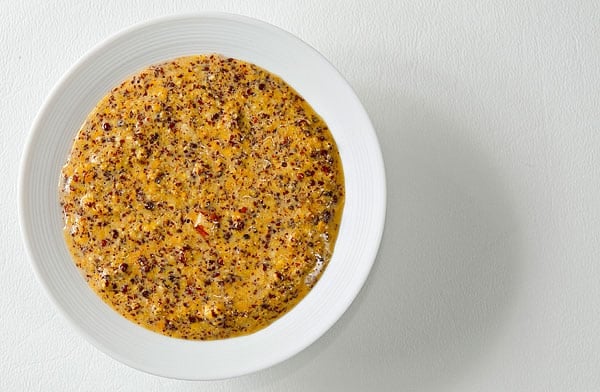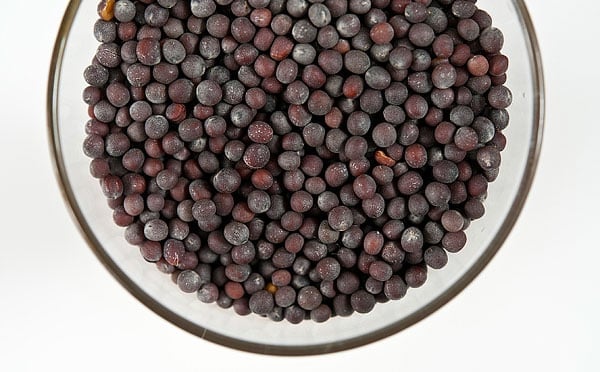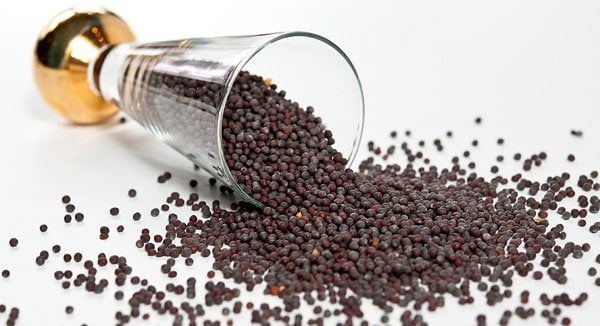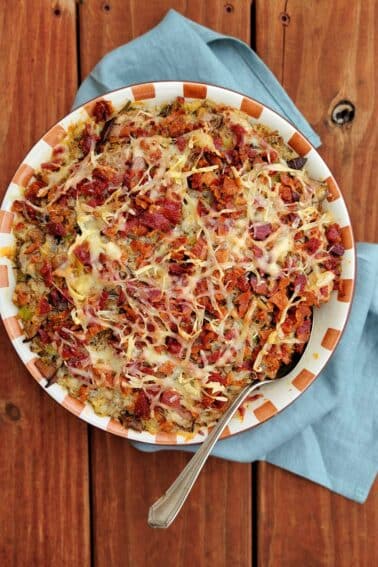As an Amazon Associate I earn from qualifying purchases.

What do you mean you can make mustard at home? It was all I could do to say, “Uh… how did you think it was made? By mustard elves under a tree?” Thankfully, I am older and nicer than I once was. Instead, I said, “Why yes, and it is really, really easy to make.”
I had this conversation with another food blogger, and I tell you this because even for even a food person to not know how to make mustard tells me that it must appear to be magic to most people. But I gotta tell ya folks, it ain’t. If you have mustard seed and water, you can make mustard. It’s that easy. And pretty much every culture in the Northern Hemisphere has done so: Mustard is to the North what chiles are to the tropics.
Mustard is a condiment of a thousand faces. Some are smooth, others almost entirely made from barely cracked seeds. Vinegar is often used, but wine, beer, grape must, and even fruit juices are used to moisten the seeds. Sweetness is usually achieved by adding honey; an American “honey mustard” can be a 1:1 ratio of mustard to honey. A Bavarian sweet mustard, however, uses only sugar and water: no acid, no honey. Italians put fruit preserves in their mustard, a practice I wholeheartedly endorse.
Mustard is one of Europe’s few native spices, although mustard also has been used in Chinese cooking for around 2,500 years as well. Ancient Rome was quite the hotbed of mustard-making, and it is Rome that gives us our name for mustard: It is a contraction of mustum ardens, or “hot must;” the Romans often added crushed mustard seeds to unfermented crushed grapes. I’ve recreated a different Roman recipe for mustard that uses almonds, pine nuts, mustard seed and red wine vinegar. The ferocious bite of this mustard — it should be made with black mustard seeds, the hottest variety — is mellowed by the richness of the nuts. It’s a great accompaniment to roasted meats.
The basic idea behind making mustard is this: Grind seeds and add cool liquid. At its most basic, this is all mustard is. Both Chinese and English mustard (think Coleman’s) is nothing more than water and mustard powder. But there are some things you need to know to make great mustard.
First, you need cold liquid. What gives mustard its bite is a chemical inside the seeds reacting with cool or cold liquid. You also need to break the seeds to get at the fiery chemical — it’s like cutting an onion. Heat damages this reaction, however, so to make a hot mustard use cold water, and warm water for a more mellow mustard. Mustard sauces lose punch when long-cooked, and should always have a little extra fresh mustard tossed in at the end of cooking.
This reaction is volatile, too. Left alone, your mustard will lose its bite in a few days, or in some cases even hours. But adding an acid, most often vinegar, stops and sets the reaction in place — this is precisely what happens with horseradish as well. Adding salt not only improves the flavor, but also helps preserve the mustard, too.
Once made, mustard is nearly invulnerable to deterioration. Mustard is one of the more powerful anti-microbial plants we know of, and, considering it is mixed with vinegar and salt, it becomes a heady mix no wee beastie can survive in. It is said that mustard will never go bad, although it can dry out.
You have three choices when it comes to which variety of mustard seed you use: White, brown and black. White mustard undergoes a different, milder reaction than do brown or black mustards, which are far zingier. American yellow mustard is made with white mustard seed and turmeric, brown mustards are in most of your better mustards, and black mustard is used in hot mustards or in Indian cuisine.

Incidentally, the wild mustard all over California is black mustard. You can thank Father Junipero Serra for that one: He used mustard, which grows like a weed, to mark his travels in Alta California 250 years ago.
The famous Grey Poupon mustard — Dijon has been a center of mustard-making for nearly a millennia now — is traditionally made with stone ground brown mustard and verjus, the tart juice of unripe grapes. I prefer this style of mustard, and most of my homemade mustards are grainy like Dijon. I grind my seeds with a spice grinder, but you could get all old school and use a mortar and pestle.
The best mustards, in my opinion, combine brown or black mustard seeds with yellow mustard powder: The two sets of chemical reactions complement each other and made a more complex mustard.
Always add water or a non-acidic liquid first, let the mixture sit for 10 minutes or so, then add the acid (vinegar, verjus, lemon juice, etc).
Add salt to taste, but it’s typically about 1 to 2 teaspoons per cup of prepared mustard.
Finally, let your mustard set in the fridge or in a cool place for at least a day before you serve it. Bitterness is a byproduct of the mustard reaction, but that bitterness fades after a day or so. Pure mustards can be kept at room temperature, but mustards with other ingredients, like the Roman nut mustard I mention above, should be kept in the fridge.
So there you have it. Easy-peasy. Now you really have no reason to ever buy mustard again.

[recipe_name]Basic Country Mustard[/recipe_name]
[summary]What could be easier than making your own mustard? No, really. It is stupid easy. Grind some mustard seeds, mix with mustard powder and some liquid and you’re done. There is no earthly reason to ever buy mustard once you learn this basic recipe. Endless variations exist. Change the liquid and you change the mustard. Grind the mustard seeds a lot or a little and you change the texture — or skip the whole seeds altogether and use just mustard powder.
Which type of mustard seed do you use? Yellow is what we Americans are most used to, but brown is spicier, more mustardy. Black mustard is stronger still, and it grows wild over much of North America; gather the seeds in late summer or early fall.
Want herbs in there? Go for it. Like honey mustard? Pour some in. Want your mustard even spicier? Add chiles or freshly grated horseradish. I even made a mustard with fresh grape juice from my backyard wine grapes. I called it Deep Purple. Weird-looking, but delicious.
The one caveat to making mustard at home is to wait. You cannot eat it the day you make it. Mustard needs to marinate to dissipate its bitterness. Try it: Eat a little dab right after you make it, then a day or two later. The difference is dramatic.[/summary]
[yield]Makes about 1 cup.[/yield]
Prep Time:[preptime time=12H] 12 hours[/preptime]
- [ingredient][amount]6 tablespoons[/amount] [item]mustard seeds[/item] [/ingredient]
- [ingredient][amount]1/2 cup[/amount] [item]mustard powder[/item] [/ingredient]
- [ingredient][amount]3 tablespoons[/amount] [item]vinegar[/item] (cider, white wine or sherry) [/ingredient]
- [ingredient][amount]1/2 cup[/amount] [item]white wine[/item] or water [/ingredient]
- [ingredient][amount]2 teaspoons[/amount] [item]salt[/item] [/ingredient]
OPTIONAL
- [ingredient][amount]2 tablespoons[/amount] [item]honey[/item] [/ingredient]
- [ingredient][amount]2 tablespoons[/amount] grated [item]fresh horseradish[/item] [/ingredient]
- 1/4 cup minced fresh herbs (really any kind)
[instructions]
- Grind the whole mustard seeds for a few seconds in a spice or coffee grinder, or by hand with a mortar and pestle. You want them mostly whole because you are using mustard powder, too.
- Pour the semi-ground seeds into a bowl and add the salt and mustard powder. If using, add one of the optional ingredients, too.
- Pour in the vinegar and wine or water, then stir well. When everything is incorporated, pour into a glass jar and store in the fridge. Wait at least 12 hours before using. Mustard made this way will last a year in the fridge.
[/instructions]




I have fallen down the mustard rabbit hole… Thanks for your information… I have black and yellow seeds and most any other ingredient… In my searches this morning, one of the cooks did say that most any other liquid than water will make it not as Hot. Which I will experiment. I’m a fan of Pomeroy, which is mild and sublime. As near as I can figure, it only tastes like Mustard… But last time I tried to make it, it came out So sharp… I am going to try soaking the seeds in wine or beer for a few days first… Anyway, I thought you mustard fiends would enjoy this article that surfaced during my googling: https://www.theonion.com/articles/man-on-internet-almost-falls-into-world-of-diy-mus,17013/ Thanks again!
Hi Hank,
thanks so much for this! I’ve been making coarse mustards with my home-brew imperial stouts, but adding nuts is an entirely new direction. I can’t wait to try it out.
One question—do you have a sense of how to recreate Colman’s mustard? It feels as though there is horseradish in it, but the ingredient list is very streamlined. How does it develop the mixture of building heat and impressively complex flavor? Do you simply use very cold water with a really high ratio of pungent seeds to water to keep it so concentrated?
Thanks,
Max
Hank,
My understanding is that the only two things which effect heat with regards to mustard are how hot/cold the water is when added to the mustard. Or if the mustard is too hot, then warming it in a saucepan to make it more mild.
I’ve read that refrigerating a mustard “sets” the heat level. I’ve also read that vinegar or an acid (lemon juice or verjus) “sets” the heat level.
I made a hotter version of a “BallPark Mustard” with a little turmeric, onion powder, paprika and salt. I also added a little gin. I haven’t added the vinegar yet to “set” the heat.
But my question: Will alcohol “set” the heat level in mustard too? What is your experience?
Thanks!
Possibly, but I think it’s the acid that does it.
HI Hank,
thanks for the cool hot tips on mustard. I hear that Canada produces like 95% of the mustard used for seeds. I want to buy mustard seeds in bulk. Got any suggestions or connects?
Thx,
Kerry
Thanks! What an interesting blog – really can’t thank you enough – learned a lot and am now on my way to making my daughter (who has a chronic illness) the great mustard she has been craving!!!!
Jarad: Nope, those aren’t the right mustards. You need Brassica nigra or B. alba. That said, you can use the seeds that come off your mustards but you won’t get many. And my advice is to just buy the seeds. Harvesting enough mustard seed for a batch of mustard is a huge pain in the ass.
So my co worker and I have decided we are going to grow our own mustard plants and horseradish roots and make an amazing mustard this summer. I am curious to know if I have the currect mustard seeds to grow in my garden to make my own mustard.
Can you make mustard from Mizuna or Florida Broad Leaf? She ordered these both and they look to be more greens than plants that will produce seeds to make mustard.
Please let me know what you think and if these are not correct, then I would greatly appreciate some more info on this.
The Hopeless Newbie Gardner
How do you harvest the seeds. I can pick wild white mustard just outside my door, but there must be a trick to getting the seeds out. Can anyone help me?
Hank,
I appreciate the time you put into the background of mustard making, and the reactions in the making process. Unsure of the process, I had been thinking of making mustard for a few weeks. After reading your article, I think I’ll have a batch made tonight.
Thank you!
Hi Hank,
What a great and inspirational website! I took the liberty to link this entry on our blog (barcodezero.com) and wanted to share this research paper on the prehistoric use of mustard in case you found that interesting: https://www.plosone.org/article/info%3Adoi%2F10.1371%2Fjournal.pone.0070583
Thanks a lot,
Robert
I made this and used 1 tsp of prepared horseradish instead of 2 Tbsp of fresh horseradish. I’ve since read that fresh horseradish is milder and more flavorful than prepared, cause this stuff is HOT!
Also, if this is your first time making mustard like it was for me and you just scan the ingredient list and go ;)… note that it will seem quite runny when you first mix it up – it thickens a lot overnight.
In India, mustard seed is almost always roasted before use. (Actually, most spices are roasted before grinding in India. Indian cooks say that it “wakes up the flavor.”) It’s easy to do, but you have to watch the seeds carefully to make sure they don’t scorch.
You put mustard seeds in a dry, medium hot skillet and keep them moving, pretty much as you would if you were popping popcorn in a pan. Soon the mustard seeds start to pop — not as spectacularly as with popcorn, but you can hear the pop and see the seeds dancing in the skillet.
The flavor of the roasted seeds is really delicious and quite different from that of raw mustard (think of the way the flavor of walnuts or pecans is enhanced when the nuts are roasted). Heat also kills the mustard’s heat; so, if you want to use roasted mustard seeds but still have the mustard spiciness, you need to combine roasted and raw mustard.
Anyway, try this with a small amount of mustard seed as an experiment. I guarantee you will like the flavor.
Finally got around to making mustard from brown and black seed. It is brutal and a bit bitter. In other words PERFECT.
I made this last week and have already almost used it all. It’s way (WAY) too hot for me uncooked, but it is delicious cooked in a sauce or as a coating on pork.
Just got your first book and have been enjoying it. My hunter and angler husband has been too.
Instead a of seeds and powder, could I just use roughly 1 cup of seeds? I like mustard relatively smooth so I would just grind the crap out of that cup. Is that viable?
I boiled my water first, then added. A month later my mustard still pops out sweat on my forehead when I eat it. Any other tricks. Yes, I used white mustard.
Thanks for your recipe, Hank. I am a bit confused how to start, though. In the introduction you say, “Always add water or a non-acidic liquid first, let the mixture sit for 10 minutes or so, then add the acid”. But in the recipe you say, “Pour in the vinegar and wine or water… Wait at least 12 hours”, with no mention of the 10 minutes at all. What should I do?
I made the basic country recipe without any extras and it was great. I tried a bit just after making it and it was very bitter. By the next day in the fridge it tasted very nice. It has that big wasabi/horseradish explosion in the nose and mouth even though it doesn’t contain either of those. It’s very reminiscent of a commercial english mustard but only grainy. Thumbs up, it was so simple.
Dan: It’s just for flavor.
Some recipes call for beer. Why? What does beer do for the mustard?